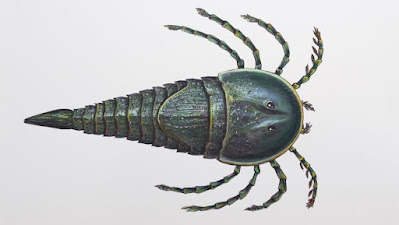ABSTRACT
A large, incomplete fragment of arthropod cuticle with distinctive tuberculate ornamentation from the late Permian Kaloola Member, Baralaba Coal Measures of the Bowen Basin in central Queensland, is assigned to the mycteropoid clade of sea scorpions. It is Changhsingian (254–252 Ma) in age and occurs in a freshwater, possibly fluvial, environment. The cuticle ornamentation consists of round to oval tubercles in two size classes and differs, in detail, from all previously described mycteropoids. We therefore propose a new species, ?Woodwardopterus freemanorum sp. nov., to accomodate this new specimen. It is at least 11 Ma younger than any previously known eurypterid fossil. This significant discovery demonstrates that large sweep-feeding eurypterids persisted until the end-Permian extinction in the southern high latitudes of Gondwana. Ecological factors that may have contributed to the survival of these freshwater eurypterids into the late Palaeozoic are also briefly discussed.
KEYWORDS: Eurypterids, mycteropoids, end-Permian, Changhsingian, Gondwana, mass extinction, ecology
Woodwardopterus freemanorum sp. nov.
Markus J. Poschmann and Andrew Rozefelds. 2022. The Last Eurypterid – A Southern High-latitude Record of Sweep-feeding Sea Scorpion from Australia constrains the Timing of their Extinction. Historical Biology: An International Journal of Paleobiology. DOI: 10.1080/08912963.2021.1998033


